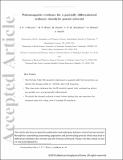Paleomagnetic evidence for a partially differentiated ordinary chondrite parent asteroid
Author(s)
Bryson, James F J; Weiss, B. P.; Getzin, B.; Abrahams, Jacob N. H.; Nimmo, Francis; Scholl, A.; ... Show more Show less
DownloadAccepted version (5.586Mb)
Open Access Policy
Open Access Policy
Creative Commons Attribution-Noncommercial-Share Alike
Terms of use
Metadata
Show full item recordAbstract
The textures and accretion ages of chondrites have been used to argue that their parent asteroids never differentiated. Without a core, undifferentiated planetesimals could not have generated magnetic fields through dynamo activity, so chondrites are not expected to have experienced such fields. However, the magnetic remanence carried by the CV chondrites is consistent with dynamo-generated fields, hinting that partially differentiated asteroids consisting of an unmelted crust atop a differentiated interior may exist. Here, we test this hypothesis by applying synchrotron X-ray microscopy to metallic veins in the slowly cooled H6 chondrite Portales Valley. The magnetic remanence carried by nanostructures in these veins indicates that this meteorite recorded a magnetic field over a period of tens to hundreds of years at ∼100 Myr after solar system formation. These properties are inconsistent with external field sources such as the nebula, solar wind, or impacts, but are consistent with dynamo-generated fields, indicating that the H chondrite parent body contained an advecting metallic core and was therefore partially differentiated. We calculate the thermal evolution of the chondritic portions of partially differentiated asteroids that form through incremental accretion across 105 to 106 years, finding this can agree with the measured ages and cooling rates of multiple H chondrites. We also predict that the cores of these bodies could have been partially liquid and feasibly generating a dynamo at 100 Myr after solar system formation. These observations contribute to a growing body of evidence supporting a spectrum of internal differentiation within some asteroids with primitive surfaces.
Date issued
2019-06Department
Massachusetts Institute of Technology. Department of Earth, Atmospheric, and Planetary SciencesJournal
Journal of Geophysical Research: Planets
Publisher
American Geophysical Union (AGU)
Citation
Bryson, James F. J. et. al., "Paleomagnetic Evidence for a Partially Differentiated Ordinary Chondrite Parent Asteroid." Journal of Geophysical Research: Planets 124, 7 (July 2019): 1880-98 © 2019 Authors
Version: Author's final manuscript
ISSN
2169-9100